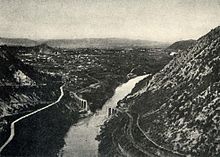Salcano Bridge
Coordinates: 45 ° 58 ′ 44 ″ N , 13 ° 39 ′ 7 ″ E
| Salcano Bridge | ||
|---|---|---|
| Salcano Bridge | ||
| Official name | Solkanski most | |
| Convicted | Week of a train | |
| Subjugated | Soča (Isonzo) | |
| place | Solkan / Salcano | |
| construction | Arch bridge (" arch bridge ") made of stone | |
| overall length | 222 m | |
| Longest span | 85 m (central arch) | |
| height | 36.3 m | |
| start of building | 1900 | |
| opening | July 19, 1906 | |
| planner | Leopold Oerley | |
| location | ||
|
|
||
The Salcanobrücke ( Slovenian Solkanski most ) is a railway bridge on the Wocheiner Railway ( Jesenice - Trieste ) in Slovenia . It is considered to be the largest brick railway arch bridge in the world.
history
The bridge is part of the railway connection ( Salzburg -) Schwarzach-St. Which was completely rebuilt by the Imperial and Royal Railway Ministry in Vienna at the beginning of the 20th century and completed in 1908 . Veit - Badgastein - Villach - Aßling - Trieste , which at that time was collectively referred to as the Tauern Railway or the New Alpine Railway . The construction project was built in three parts, the actual Tauernbahn, the Karawankenbahn and the Wocheiner Bahn; the planning was carried out by engineers from the ministry. The railway was supposed to connect the southern German, western Austrian and southern Bohemian regions much better than before with Trieste and the port of Trieste (the main trading port in old Austria).
Leopold Oerley was responsible for the planning and construction management of the Salcanobrücke . At the time of its construction it was "currently the largest arched railway bridge in the world". In the contemporary description it is called the “most beautiful bridge structure on the railway” over the “emerald green Isonzo”. Coming from Jesenice there are five tunnels and a 163 m long viaduct in front of the bridge, after the bridge the route continues to Gorizia .
The opening of the Wocheiner Bahn took place on July 19, 1906 in the presence of Archduke Franz Ferdinand of Austria-Este and the Imperial and Royal Railway Minister Julius Derschatta von Standhalt (1852-1924), with the entire Wocheinerbahn to Trieste being traveled by court train.
Concerning the building material of the bridge, the contemporary source reports that the technicians (after many iron bridges) returned to stone for supporting structures. It is usually available directly at the construction site or nearby, in permanent and reliable quality, and it is also cheap. You can therefore see many fractures along the path with the degradation of the rock, which in their characteristic limestone light, especially in the karst regions, shine dazzlingly in the sun's rays.
4533 hewn stones, which were transported from the limestone quarries of Nabresina (today: Aurisina ; approx. 15 kilometers northwest of Trieste, in the Karst), were bricked up in just 18 days. The keystone was inserted on July 1, 1905. The wooden frame was removed in mid-August and it was only lowered by 6 mm due to its dead weight.
On the night of August 8th to 9th, 1916, the main arch of the bridge was blown up during the Sixth Isonzo Battle by Austro-Hungarian pioneers while retreating with 930 kilograms of Ekrasite , as it was feared that it could be of use to the Italian enemy. In May 1918, train traffic was resumed over an iron Roth-Waagner temporary bridge .
After the First World War , the southern part of the Wocheiner Railway came to Italy with the Salcanobrücke. The operator of the route was now the Italian State Railways (FS) . The bridge was rebuilt in 1925–1927. It was rededicated in August 1927.
During World War II , Western Allied bombers attacked the bridge on August 10, 1944; but she was not hit. On March 15, 1945 the bridge was hit, but the bomb did not explode. There was only one hole in the bridge deck.
The bridge has been under state protection as a technical monument since 1985 .
gallery
Salcano Bridge seen towards Nova Gorica
literature
- Gorazd Humar: Kamniti velikan na Soči. Branko, Nova Gorica 1996, ISBN 961-6079-30-1 .
- Gorazd Humar, Bogdan Kladnik: Slovenski Mostovi: Bridges of Slovenia. Part 2: Štajerska, Dolenjska, Gorenjska, Prekmurje. Zaklad, Ljubljana 2002, ISBN 961-6266-12-8 .
- Karl-Eugen Kurrer : The History of the Theory of Structures. Searching for Equilibrium . Berlin: Ernst & Sohn 2018, p. 241ff., ISBN 978-3-433-03229-9 .
Web links
Individual evidence
- ↑ Austria's hoard. Historical and cultural images from the Habsburg hereditary lands. A solemn offering to the Austrian people for the jubilee celebration of Emperor Franz Josef I in 1908 , published by a group of writers from the fatherland; Patriotic Volksbuchhandlung, Vienna 1908, Volume II, Section Opening up the Eastern Alps through the Locomotive , p. 675 f.
- ↑ Austrian Biographical Lexicon 1815–1950
- ^ Oesterreichs Hort , Volume II, p. 679
- ↑ a b c d www.bmlv.gv.at
- ↑ Interesting news - The largest stone railway bridge . In: Bozner Nachrichten . tape 12 , no. 191 , August 22, 1905, p. 6 ( digital.tessmann.it [accessed February 8, 2015]).
- ^ Andreas Knipping : Railways in World War I , EK-Verlag, Freiburg 2004, ISBN 3-88255-691-9 , p. 115





